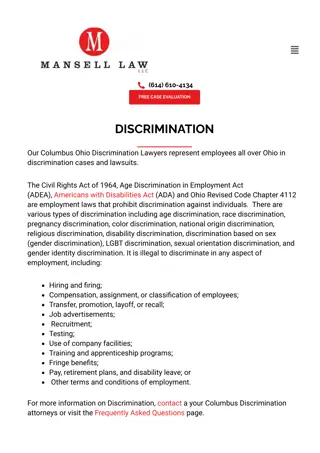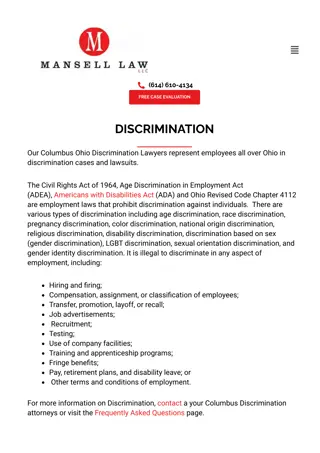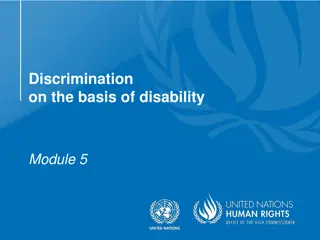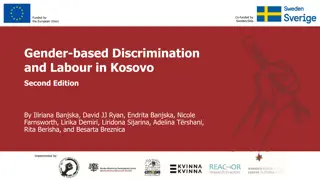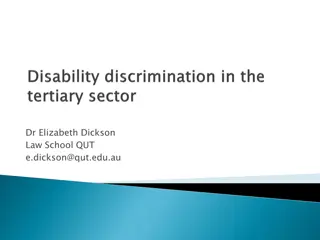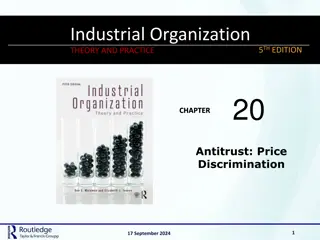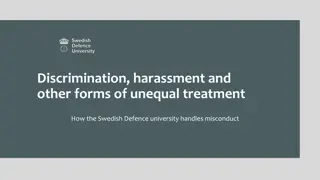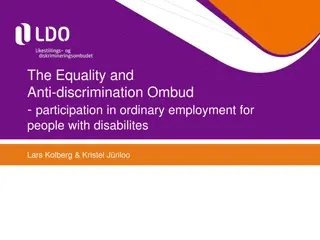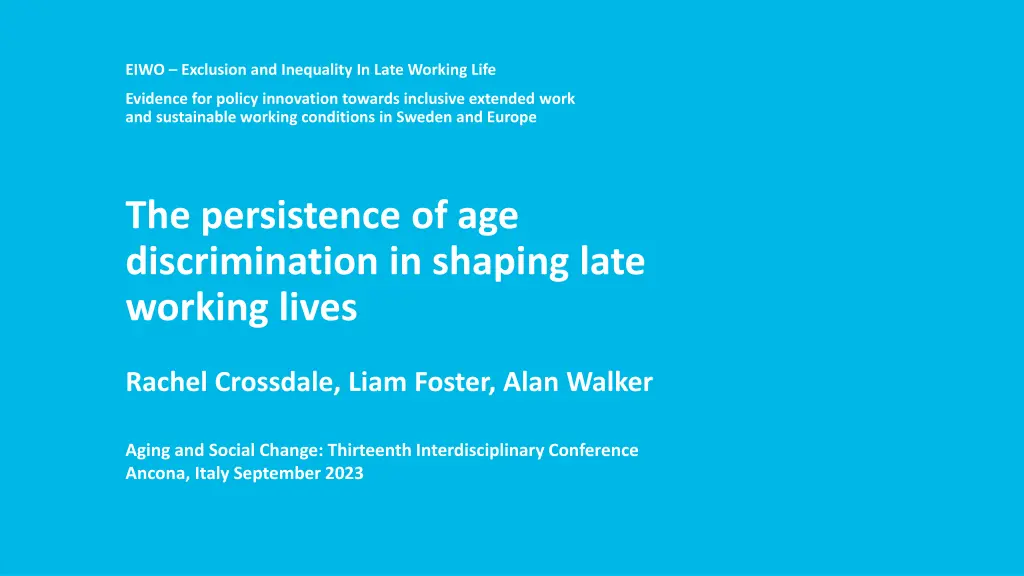
Addressing Age Discrimination and Inequality in Late Working Life
Explore the persistence of age discrimination and exclusion in late working life, focusing on evidence from Sweden and Europe. Discover how ageist practices impact retirement preferences and the Extended Working Lives movement, highlighting the need for inclusive policies and sustainable working conditions.
Download Presentation

Please find below an Image/Link to download the presentation.
The content on the website is provided AS IS for your information and personal use only. It may not be sold, licensed, or shared on other websites without obtaining consent from the author. If you encounter any issues during the download, it is possible that the publisher has removed the file from their server.
You are allowed to download the files provided on this website for personal or commercial use, subject to the condition that they are used lawfully. All files are the property of their respective owners.
The content on the website is provided AS IS for your information and personal use only. It may not be sold, licensed, or shared on other websites without obtaining consent from the author.
E N D
Presentation Transcript
EIWO Exclusion and Inequality In Late Working Life Evidence for policy innovation towards inclusive extended work and sustainable working conditions in Sweden and Europe The persistence of age discrimination in shaping late working lives Rachel Crossdale, Liam Foster, Alan Walker Affiliation and further information Aging and Social Change: Thirteenth Interdisciplinary Conference Ancona, Italy September 2023
The persistence of age discrimination in shaping late working lives Background Methods Findings Health pessimism Public perceptions Generational contract Alienation Retirement fantasy Structural and internal factors
Background Fluctuating employment rate for older workers early retirement, health reasons, and redundancy were consistently the main reasons for people aged 65 and over leaving a job over the five year period 2017-2022 (UK LFS, 2022) National-level EWL policies have been a mixture of carrot and stick initiatives Tackling age discrimination has been mostly left to employer level policies Age discrimination (and in particular ageist stereotypes and stereotypical attitudes) within the workplace have been subjects of research and policy since the 1990 s. Institutional ageism is pervasive, causing self-exclusion from promotion, training, and paid work Current measures are not extensive enough to bridge the predicted employment shortfall long-term and lack the nuanced approach to factors that limit workers choices. Ageist practices continue in the labour market and continue to have a negative impact on retirement preferences and the Extended Working Lives movement
Methods UK data from EIWO interviews with older workers about risks and coping strategies in working life A theme of self-deprecating language in the UK interviews Coded to age discrimination during analysis of risks and coping strategies Revisited the code and coded into sub-themes Research Questions: 1. How do older workers perceive themselves and their role in the labour market? How does this compare with ageism and ageism discourse? 2.What do older workers perceptions of themselves within the labour market mean for an Extended Working Lives agenda?
Public perceptions Findings Generational Contract Health Pessimism Alienation Retirement fantasy
Findings: Health Pessimism Participants spoke with a sense of impending and inevitable deterioration to health. Participants felt physically and mentally slower than younger workers. You just get tired. I m weary. I m weary. I think that s what I tell people, my brain is weary. I know I m not old-old, but I haven t got that many years left (F, 60-64) it's just a matter of fact, you slow up, your thinking slows up. It's difficult to, to maintain that high level of output that's required of people (M, 55-59) This was talked about as an irreversible and inevitable side effect of ageing. This was both a facilitator and barrier to EWL as older workers did not want to miss a window of good health for retirement, but also saw working as a way of maintaining mental and physical health.
Findings: Public Perceptions Older workers believed they were seen as respected, wise, experienced, credible, and in a mentor role [a younger colleague] asks my advice about professional matters which I can offer as more of a almost paternally Sometimes with younger people, if you think, I ve been there, I know what the issues are, I know where you are at the moment (M, 65-69) This was linked to appearance with phrases such as see experience (F, 55-59), grey/white heads (M, 55- 59). Some participants felt they did not have the right image for their employer any more. They d got specialist teams in to rebrand, and they wanted a youthful profile, and I don t think my image was what they wanted at the end really (F, 65-69) There was a notable link between appearance, age, and health.
Findings: Generational contract Despite a wealth of evidence to the contrary, the narrative persists that older workers are taking jobs from younger workers. If somebody wants to carry on working, you know, let them do so. I think the sad thing though is if it s blocking someone else, then that s pretty bad fallout (M, 65-69) It was felt that younger people were more deserving of the resources afforded to older workers as younger workers could use these resources for progression. I think the most negative [perception] is that older people are not up to their jobs, and they should make way for younger people, and that they are stealing employment from younger people who need the income and the sense of progression in their lives (F, 55-59)
Findings: Alienation For some there was a feeling of being alienated from the workplace. This was primarily linked to technology and social interactions. Technology has moved on quite a lot and sometimes I feel a little bit out of my depth (F, 65-69) Participants blamed a generation gap, claiming that younger workers have been brought up with technology and take to it a lot easier. There was little interest in the mandatory learning of new digital skills for job retention Technology is noted as a barrier for older workers in finding employment as there is emphasis on a high- level of digital skills in job applications (which are primarily online). Part-time workers feel the rift in social connection, especially when having reduced from full-time work previously You re just not part of the team, you're not included as much (ST Female, 60-64)
Findings: Retirement fantasy Some participants positioned retirement as a completely separate stage of life from their current working life. Support was a key theme, with participants factoring family responsibilities into their retirement planning. Retirement was also perceived as a time for leisure activities of personal interest that are not time-compatible with working life. Examples were writing a book (F, 55-59), crafts (F, 60-64, F, 55-59), gardening (M, 65-69), and voluntary work (M, 60-64, F, 60-64, M, 60-64). Travel was also a key theme; however participants were not wanting to travel for a typical holiday, rather for a cultural experience far removed from their current or previous activities. There was the sense that plans for retirement were not entirely realistic. In most cases no tangible planning had gone into these retirement plans. Hopefully time to do the kind of things that you think about doing when you're younger you think oh, when we retire we'll have time to do this that and the other (F, 60-64) This also demonstrates that ideas about retirement were based on achieving goals built up over the life course that were perceived as unachievable due to commitments, responsibilities, and financial constraints prior to retirement.
Structural and Internal factors The findings can be loosely categorised into two themes: Structural factors and Internalised impairments to identity. Structural factors Social interactions Digitisation and technology Internalised impairments to identity Ageing = poor health Perceived as old
Interaction These structural factors and internalised perceptions interact, with structural factors contributing to older worker s perceptions of themselves and internal perceptions resulting in a skewed health expectation and self-exclusion from activities Predominantly negative results, but there could be positive effects
Conclusion Recent increase in older people leaving the labour market due to retirement, health and redundancy Employment rate for people aged over 65 has not recovered to pre-pandemic levels Institutional ageism has been on the radar since the early 1990s but both structural and internalised ageism persist in the workplace. Structural and internalised ageism continue to play a significant part in the decision- making process of older workers when considering their future. the two interact in an iterative relationship, with structural factors impacting personal perceptions and individual barriers reinforcing structural factors with disengagement and self-exclusion


